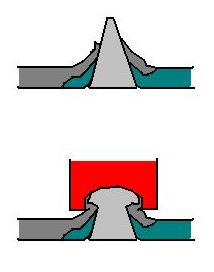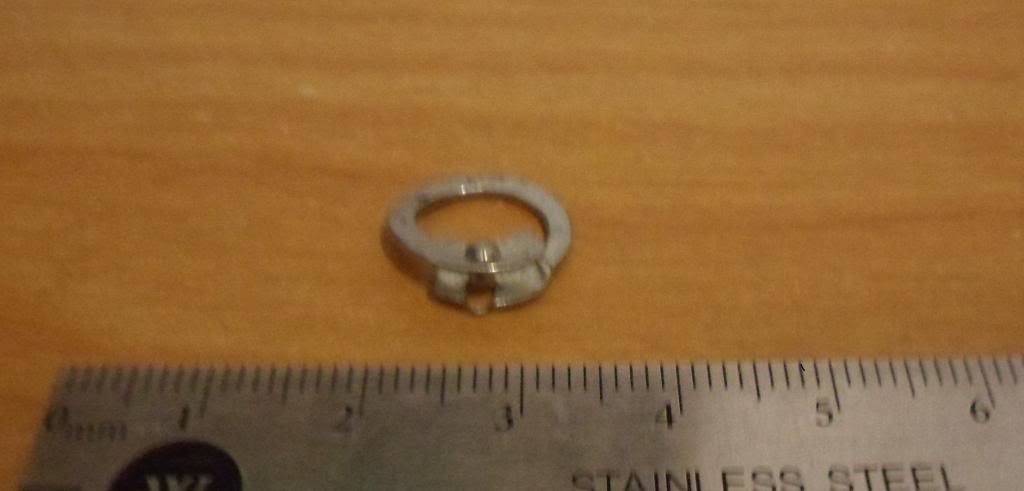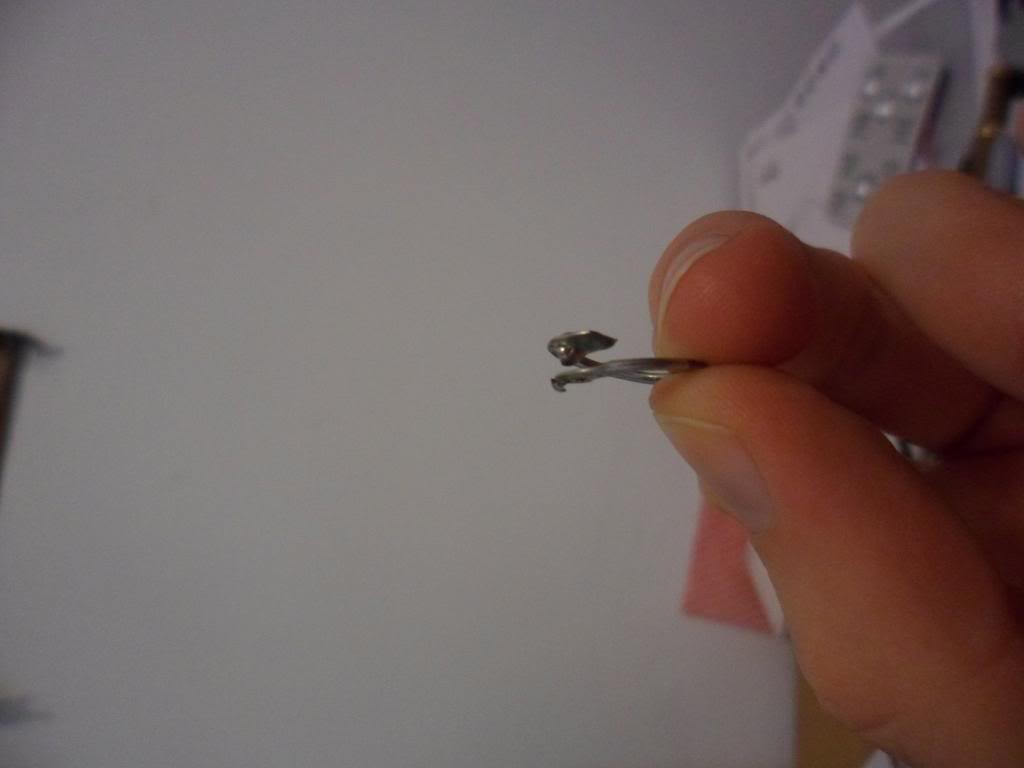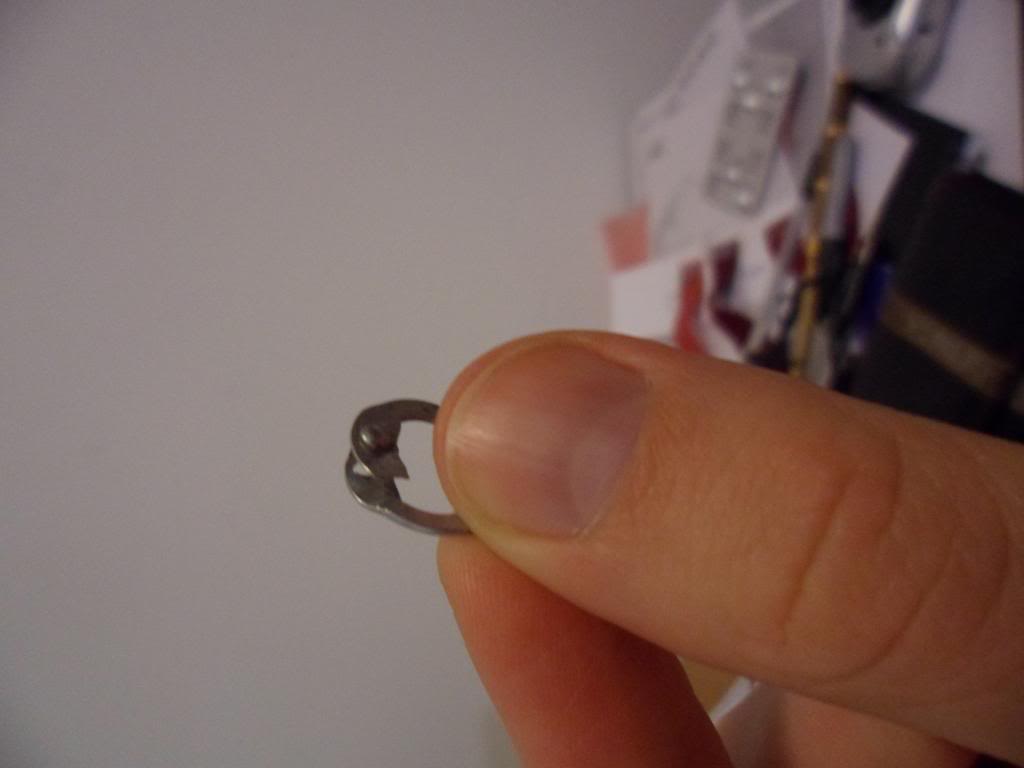| Author |
Message |
|
William P
|
 Posted: Thu 04 Aug, 2011 5:20 pm Post subject: Posted: Thu 04 Aug, 2011 5:20 pm Post subject: |
 |
|
|
and just to clarify to use a drift is just to poke a hole in the material??
|
|
   |
 |
Dan Howard

|
 Posted: Thu 04 Aug, 2011 5:54 pm Post subject: Posted: Thu 04 Aug, 2011 5:54 pm Post subject: |
 |
|
| Quote: | | I can say that the rings are done with a drift as there is no sign of material being removed. I wonder if this is either a) a sign of the times or b) just relevant to the wedge rivet flat rings and the round rivets are still punched |
It is a good sign. The last wedge-riveted links I saw had rectangular holes that had definitely been punched.
| Quote: | | and just to clarify to use a drift is just to poke a hole in the material?? |
I've had this illustration on my HDD for a while. IIRC it came from Erik. Apologies if someone else did the drawing. Note how the drift has pushed the metal out of the way to let the rivet through and how this metal helps hold the rivet in place after peeening.
 Attachment: 7.32 KB Attachment: 7.32 KB

|
|
  |
 |
Sander Marechal

|
 Posted: Wed 10 Aug, 2011 1:31 pm Post subject: Posted: Wed 10 Aug, 2011 1:31 pm Post subject: |
 |
|
| Dan Howard wrote: | | Quote: | | I can say that the rings are done with a drift as there is no sign of material being removed. I wonder if this is either a) a sign of the times or b) just relevant to the wedge rivet flat rings and the round rivets are still punched |
It is a good sign. The last wedge-riveted links I saw had rectangular holes that had definitely been punched. |
I bought loose rings from Cap-a-pie and I have seen the same thing. The wedge-riveted rings have holes made by a drift. The round-riveted rings have holes made by a punch.
The Knights Hospitaller: http://www.hospitaalridders.nl
|
|
    |
 |
Dan Howard

|
|
  |
 |
|
S. Sebok
|
 Posted: Wed 17 Oct, 2012 8:48 pm Post subject: Posted: Wed 17 Oct, 2012 8:48 pm Post subject: |
 |
|
|
Well after reading this whole thread I wish I discovered it sooner. I got a few things to add to it. I do realize indian made maille is rather inferior in quality to real historical maille. But I would like to say I think wedge riveted indian maille is closer to actual historical wedge riveted maille than indian dome riveted maille is to historical dome riveted maille. The main difference is the lack of the triangular end of where the rivet comes out as seen in historical examples. Dome riveted is nothing like the historical type as it has that double ended rivet, that creates a lot of problems, such as rivets falling out easily and whatnot and extra wear to gambeson. Indian wedge riveted doesn't usually have the problem unless the holes are punched rather than drifted. Still think the rings are a bit too thin though, now that I have seen Erik's maille up close and actually own a coif by him by sheer luck. It would be nice to see indian made maille that uses Erik's way of making it then I would for sure buy one.
|
|
  |
 |
|
Jonathon Hanson
Location: Pittsburgh, PA Joined: 11 Mar 2010
Posts: 23
|
 Posted: Fri 19 Oct, 2012 5:54 pm Post subject: Posted: Fri 19 Oct, 2012 5:54 pm Post subject: |
 |
|
I'm trying to assemble a haubergeon myself out of loose rings, and as such have a few experiences to share. I think that the GDFB flat ring round rivet rings work very well with the Ring Lord punched washers, but Kult seems to be constantly out of stock on them. I then got some rings from another supplier (silly me) that I assumed were the same. What I eventually learned was that the places in India make rings out of 18g wire as well as 17g wire. The punch hole in both is the same size, which means that the 18g rings are weaker- probably not armor grade. The 17g rings seem to be very durable though, maybe not as much as real round rivet mail but good enough for most uses.
The moral of my story is that not all mail rings are created equal- even within the same factory, different wire sizes are used which can compromise the quality of the product. Always be sure beforehand of the wire thickness of your loose rings before ordering them.
|
|
  |
 |
|
Sean Manning
|
 Posted: Tue 13 Nov, 2012 4:55 pm Post subject: Posted: Tue 13 Nov, 2012 4:55 pm Post subject: |
 |
|
For reference, here is a failed ring from an all-riveted hauberk by one of the companies that imports Indian maille. There are a lot of types and levels of craftsmanship available today, so a prospective buyer should think carefully and ask lots of questions. Getting armour which is much too big, or shreds your arming garments, or weighs twice as much as you expect can be an unpleasant surprise. None of the Indian rings is very accurate, but rivet type and wire cross section are not the only ways to be less wrong.



Note that the rivert hole is so off center that the ring burst open when the rivet was peened. I would estimate that one in a thousand links in this garment was ready to fall apart, and one in ten is dubious. If we pay careless, unskilled work prices we get careless, unskilled work quality!
To my inexpert eye, about two thirds of Dan's criticisms apply to this ring as a simulation of the ability of late 14th century maille to resist edges and points. The weight of the wire is similar to the heavy examples published by Burgess and Smith, the overlap is generous (but squeezed thin), and the rivet holes are round. The hauberk has other bigger problems as a simulation of how late 14th century armour looked and moved.
|
|
  |
 |
Dan Howard

|
 Posted: Tue 13 Nov, 2012 8:28 pm Post subject: Posted: Tue 13 Nov, 2012 8:28 pm Post subject: |
 |
|
That would fall under point 3
| Quote: | | * Rivet holes are either too large or not centred. Both will leave too little material on one or both sides and the link will tear too easily. |
|
|
  |
 |
|
Mart Shearer
|
 Posted: Tue 13 Nov, 2012 9:40 pm Post subject: Posted: Tue 13 Nov, 2012 9:40 pm Post subject: |
 |
|
I've seen a couple of metalurgical analyses of mail which document the rivet size pretty thoroughly. A rivet of .5-.7mm diameter in wire beginning at 1mm-1.6mm seems normal. Are the modern Indian rivets simply too large for the wire used in the ring?
ferrum ferro acuitur et homo exacuit faciem amici sui
|
|
  |
 |
Boris Bedrosov
Industry Professional

Location: Bourgas, Bulgaria Joined: 06 Nov 2005
Posts: 700
|
 Posted: Tue 13 Nov, 2012 10:53 pm Post subject: Posted: Tue 13 Nov, 2012 10:53 pm Post subject: |
 |
|
As you know, my Yushman project is made with riveted maille. I bought it from an European supplier, but I'm 99,9% sure that it's Indian of origin.
Answering your question I could give you these sizes - my links are approx. 1.45 mm in diameter, while the rivets are 1.3-1.35 mm.
Other interesting issue is the quality - it strongly depends on the particular lot. What I mean - I was delivered my links in two shipments. With first I had no problems - when riveting its links, I got torn link with ratio about 2 or 3 of 100 (or 2 - 3%). But with the other shipment this ration was average about 1 or 2 of 10 (10 - 20%), while sometimes it was disastrous - about 35 - 45%.
"Everyone who has the right to wear a long sword, has to remember that his sword is his soul,
and he has to separate from it when he separates from his life"
Tokugawa Ieyasu
Find my works on Facebook:
Boris Bedrosov's Armoury
|
|
   |
 |
|
Sean Manning
|
 Posted: Wed 14 Nov, 2012 6:34 pm Post subject: Posted: Wed 14 Nov, 2012 6:34 pm Post subject: |
 |
|
| Dan Howard wrote: | That would fall under point 3
| Quote: | | * Rivet holes are either too large or not centred. Both will leave too little material on one or both sides and the link will tear too easily. |
|
I agree. This sample probably has problems 2-5 and 8 but not 1, 6, or 7. My concerns with the OP are that it treats all Indian maille as identical and doesn't distinguish between the things which matter for an armour test and the things which matter for having a kit which looks and moves correctly. For example, one disadvantage of getting galvanized maille is that its hard to buy galvanized rivets and links to tailor it.
|
|
  |
 |
|
William P
|
 Posted: Mon 27 Apr, 2015 4:46 am Post subject: Re: "Riveted" does not equal "Historical" Posted: Mon 27 Apr, 2015 4:46 am Post subject: Re: "Riveted" does not equal "Historical" |
 |
|
| Dan Howard wrote: | OK this is so I don't have to post the same thing every time someone tries to claim that this or that riveted mail armour they bought from this or that supplier is "historical".
Firstly, it doesn't matter which supplier you buy the mail from, most come from the same manufacturers in India and Pakistan. The only commercial supplier of mail who attempts to replicate museum examples is Erik D Schmid.
Here is a list explaining why the Indian mail in no way resembles historical mail. It largely refers to wedge-riveted mail but most of the points are also relevant for round-riveted mail. All of the following will make the armour a lot more susceptible to weapons than historical examples (which is why it is completely unsuitable for weapons vs armour testing).
* The thickness of the wire is generally too light for the diameter of the link, making it lighter but less capable of resisting a weapon.
* Holes are made with a punch rather than a drift. This leaves a lot less metal around the rivet to help secure it.
* Rivet holes are either too large or not centred. Both will leave too little material on one or both sides and the link will tear too easily.
* The links are hammered way too thin (probably to make them easier to punch), but this greatly reduces the strength of the link
* Rivets are incorrectly set. If a rivet is not peened tightly, the link will pull apart too easily
* There isn't enough overlap in the lapped section of the link to create a decent join
* Wrong shape rivet hole. Indian mail has rectangular holes. Historical wedge-riveted mail has ovoid holes. Rectangular holes tear very easily at the corners. Circular or ovoid holes are much stronger
* Incorrect metallurgy. Mild steel (or even so-called modern "iron") is not as ductile as bloomery iron and it is more likely to snap upon impact instead of stretching/bending
Another point: BUY GALVANISED MAIL! As noted above, nothing you will buy will have much in common with historical mail. Stripping off the zinc will not make it any more authentic. May as well save yourself the trouble of keeping it clean. You can treat it so that it darkens to look like iron or you can let it darken naturally. |
yes i was wondering about that part regarding metallurgy, mostly in reference to late dark age / eearly medieval maille used by the scandinavians rus and byzantines since thats the period me and my friends focus on
one thing ive heard is that 'we're useing far stronger materials than they would have had since the best steels would be used to make weapons etc. suggesting that any maille we make, including the indian maille. and those in michael edelsons test are actually OVERbuilt by comparison
|
|
   |
 |
Dan Howard

|
 Posted: Mon 27 Apr, 2015 7:06 am Post subject: Posted: Mon 27 Apr, 2015 7:06 am Post subject: |
 |
|
The exact metallurgy of the link is far less important than all the other of the points I listed. It doesn't matter what the Indians make their links from, they are still going to be a lot more susceptible to breakage than proper riveted mail. You'd need to use both modern alloys AND the correct links to improve protection beyond what they had historically.
Author: Bronze Age Military Equipment, Pen and Sword Books
|
|
  |
 |
Kuo Xie

Location: Chicago, IL Joined: 29 Feb 2012
Posts: 76
|
 Posted: Mon 27 Apr, 2015 8:32 am Post subject: Posted: Mon 27 Apr, 2015 8:32 am Post subject: |
 |
|
| Sean Manning wrote: | For reference, here is a failed ring from an all-riveted hauberk by one of the companies that imports Indian maille. There are a lot of types and levels of craftsmanship available today, so a prospective buyer should think carefully and ask lots of questions. Getting armour which is much too big, or shreds your arming garments, or weighs twice as much as you expect can be an unpleasant surprise. None of the Indian rings is very accurate, but rivet type and wire cross section are not the only ways to be less wrong.
|
Hi,
I have an Indian-made dome riveted hauberk that I'm tailoring and I can support this statement. That picture you posted is sadly a familiar sight to me, as I've broken quite a few rings in the riveting process. Quite a few of the rings have the rivet hole punched too close to the edge of the ring, so when you try to flatten the rivet it breaks through the side of the ring. The rivets are also pretty high profile so they tend to catch on each other when the hauberk is folded up. The Indian mail is better than it used to be but still has a long way to go.
Here's a trick I use when working with Indian-made rings. Instead of using the steel dome rivets they supply - which can break the rivet holes when they deform - I make my own "rivets" out of soft aluminum wire. I cut the wire into 3mm lengths which seal the rivet holes quite securely when clamped down. They are a lot easier to clamp as well. Certainly it's not a historical solution, but it forms a strong seal and the Indian stuff is not super-authentic to begin with.
|
|
  |
 |
|
Houston P.
Location: United States Joined: 20 Apr 2015
Posts: 83
|
 Posted: Mon 27 Apr, 2015 9:02 am Post subject: Posted: Mon 27 Apr, 2015 9:02 am Post subject: |
 |
|
Just a quick thought here; we know there was a varying level of quality in plate armor, couldn't it have been the same with mail? A better craftsman may be pickier about say the centering of the rivets and having the rings all lay correctly whereas a poorer guy might not have enough to get that level of attention to detail, and any protection is better than no protection, so do you think this could have been the case?
...and he that hath no sword, let him sell his garment, and buy one. (Luke 22:36)
|
|
  |
 |
|
Erik D. Schmid
Location: St. Cloud, MN Joined: 21 Aug 2003
Posts: 80
|
 Posted: Mon 27 Apr, 2015 9:25 am Post subject: Posted: Mon 27 Apr, 2015 9:25 am Post subject: |
 |
|
| Houston P. wrote: | | Just a quick thought here; we know there was a varying level of quality in plate armor, couldn't it have been the same with mail? A better craftsman may be pickier about say the centering of the rivets and having the rings all lay correctly whereas a poorer guy might not have enough to get that level of attention to detail, and any protection is better than no protection, so do you think this could have been the case? |
Absolutely. Mail differed in quality as much as plate did. Even in higher quality pieces, no two links will be identical. As I have stated in the past, each link needs to be viewed as a single piece of armour in its own right.
With regards to Indian mail I would advise people to steer clear of the titanium pieces. I've had several in my hands needing major repairs right out of the box and these were the norm and not the exception unfortunately. The riveting process that is used by Indian manufacturers is no friend of this metal by any means.
http://www.erikds.com
|
|
   |
 |
Dan Howard

|
 Posted: Mon 27 Apr, 2015 2:04 pm Post subject: Posted: Mon 27 Apr, 2015 2:04 pm Post subject: |
 |
|
| Houston P. wrote: | | Just a quick thought here; we know there was a varying level of quality in plate armor, couldn't it have been the same with mail? A better craftsman may be pickier about say the centering of the rivets and having the rings all lay correctly whereas a poorer guy might not have enough to get that level of attention to detail, and any protection is better than no protection, so do you think this could have been the case? |
As Erik said there was a lot of variation in mail. But there was no such thing as "cheap" mail. Mail was the most expensive and time consuming type of armour ever invented yet it was the preferred armour all over the world for the best part of two thousand years. The amount of labour required just to produce the required length of wire (one-two thousand feet) would exceed that of many other types of armour. The difference in the quality of riveting would be like comparing a $400,000 sportscar and a $500,000 one. None of them are affordable by the majority of the population. The Indian mail, by comparison, is a poorly-made, mass produced family sedan.
Author: Bronze Age Military Equipment, Pen and Sword Books
|
|
  |
 |
|
Houston P.
Location: United States Joined: 20 Apr 2015
Posts: 83
|
 Posted: Mon 27 Apr, 2015 2:43 pm Post subject: Posted: Mon 27 Apr, 2015 2:43 pm Post subject: |
 |
|
Sorry for my lack of clarity there. By poorer I only meant to convey less expense. I wasn't trying to suggest any of it was cheap by any means, only that there would be varying levels of quality and therefore price, as seen in plate. I've seen some plate that was obviously cheap and barely more than a flattened bar, so I thought maybe there would be mail that was somewhat "rushed" ( not to say it could be done quickly) just to get it out there, if that makes sense. Kind of an " I don't have armor and I need some A. S. A. P. " situation. And if that was the case then some of it might have been somewhat clunky, more like what we have in some reproductions ( though I highly doubt any of it was ever that bad). Of course this is purely speculative and really means very little, and you all have probably forgotten more than I'll ever know about mail.
...and he that hath no sword, let him sell his garment, and buy one. (Luke 22:36)
|
|
  |
 |
|
Timo Nieminen
|
 Posted: Mon 27 Apr, 2015 4:01 pm Post subject: Re: "Riveted" does not equal "Historical" Posted: Mon 27 Apr, 2015 4:01 pm Post subject: Re: "Riveted" does not equal "Historical" |
 |
|
| William P wrote: | yes i was wondering about that part regarding metallurgy, mostly in reference to late dark age / eearly medieval maille used by the scandinavians rus and byzantines since thats the period me and my friends focus on
one thing ive heard is that 'we're useing far stronger materials than they would have had since the best steels would be used to make weapons etc. suggesting that any maille we make, including the indian maille. and those in michael edelsons test are actually OVERbuilt by comparison |
Apart from the points above, consider how mail fails, assuming the rivet holds. A point will go into a link, and spread it, until it snaps. For mail to work as well as possible, you want it to take the largest amount of energy possible to snap the link.
For a modern steel to be considered "strong", it needs to be able to sustain large forces (and therefore large deformations) without permanently deforming (i.e., the deformation needs to be within the elastic limit). This doesn't mean it will make ideal mail. For mail, you don't care if the link deforms permanently as long as it sucks up that energy doing so. To suck up more energy, you want it to deform a long way - ductility is very important.
Wrought iron is more ductile than mild steel, and medium/high carbon steel. It will deform much further before it breaks. Since the wrought iron used for drawn-wire mail has been drawn into wire, it doesn't have too many defects, and is ductile. Wrought iron mail is likely to outperform modern mail made of the steels commonly used for modern mail.
We could do better than wrought iron. "Pure iron" (basically, very low carbon, low impurity iron) is basically like wrought iron, without the slag. Using steels that will sustain very large deformations (elastically) might work well, too. Maraging steels and spring steels might work well. But the usual modern mail is not made with such steels.
"In addition to being efficient, all pole arms were quite nice to look at." - Cherney Berg, A hideous history of weapons, Collier 1963.
|
|
   |
 |
Dan Howard

|
 Posted: Mon 27 Apr, 2015 7:01 pm Post subject: Posted: Mon 27 Apr, 2015 7:01 pm Post subject: |
 |
|
Stretched, dented, and twisted links are good. It means that they have absorbed energy that would otherwise have gone to the wearer. If you come out of a battle with your armour completely destroyed but you are relatively unhurt, then it has done its job.
Author: Bronze Age Military Equipment, Pen and Sword Books
|
|
  |
 |
|
|
You cannot post new topics in this forum
You cannot reply to topics in this forum
You cannot edit your posts in this forum
You cannot delete your posts in this forum
You cannot vote in polls in this forum
You cannot attach files in this forum
You can download files in this forum
|
All contents © Copyright 2003-2024 myArmoury.com — All rights reserved
Discussion forums powered by phpBB © The phpBB Group
Switch to the Basic Low-bandwidth Version of the forum
|

